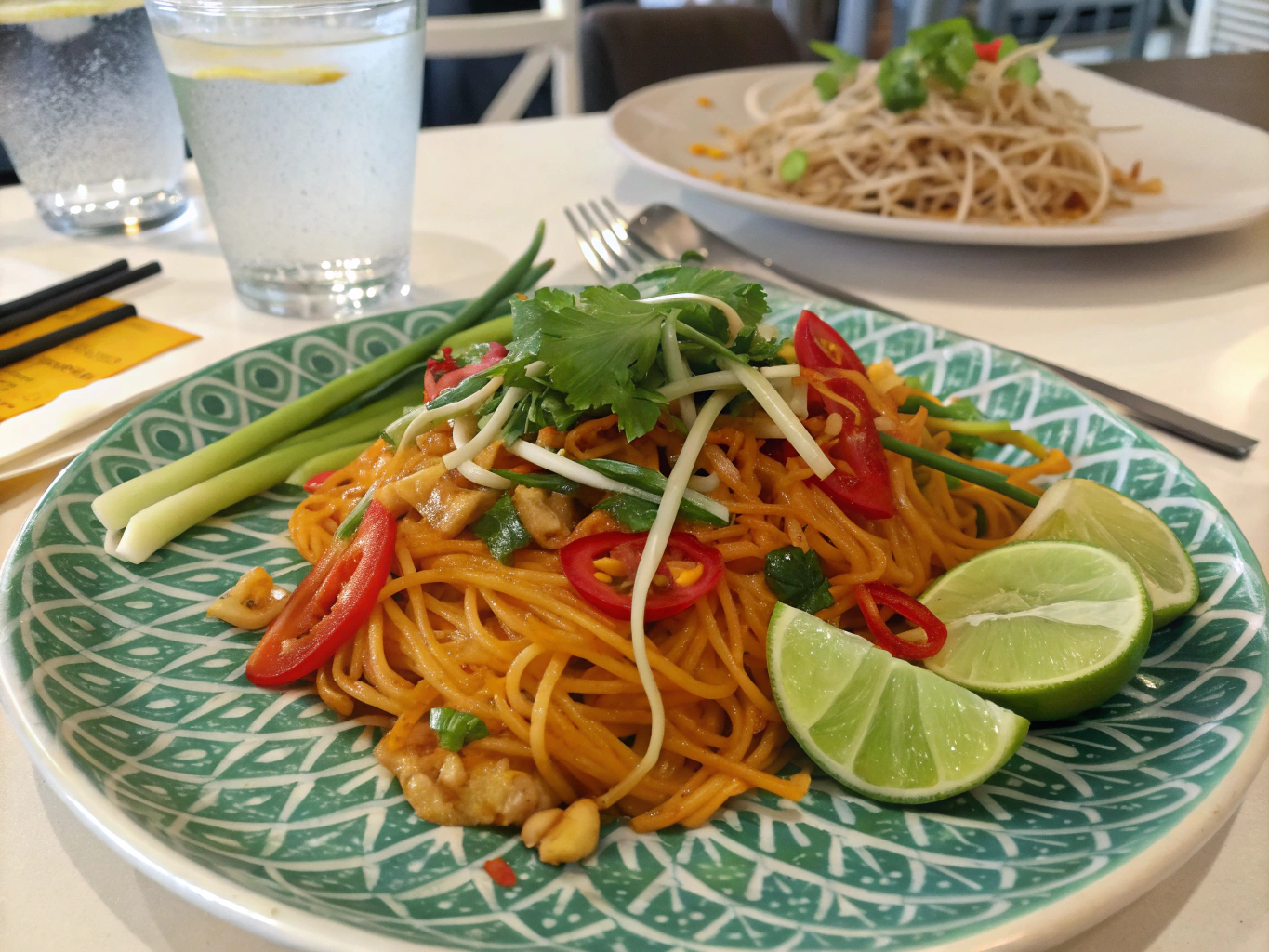
There’s just something magical about a bowl of Thai noodles. The chewy slurp of rice noodles, the swirl of tangy, spicy, sweet sauce, and that satisfying finish of herbs and crunch—each bite is layered with flavor. In this article, you’ll discover not only how to make a comforting Thai noodle dish at home without stress, but you’ll also learn about its cultural roots, cooking tips, and how to make it your own. Whether you’re a weeknight hero or weekend experimenter, this guide delivers everything you need—fast, flavorful, foolproof.
The Flavor Story: How Thai Noodles Became My Weeknight Favorite
Thai Noodles and a Grandma’s Secret
I’ve been a curious cook since childhood. Growing up in Charleston, my grandmother was the master of comfort food. While she didn’t cook Thai food, her method stuck with me: “use your nose, your hands, and your heart.” That’s exactly how I stumbled into Thai noodles in my early twenties. I tried them at a bustling food market in Atlanta—the aroma alone pulled me in. The first bite? Game-changer. That experience sparked my love affair with Thai flavors. Now I recreate that magic in a way that respects tradition but keeps things fresh and doable in any kitchen.
More than just a meal, Thai noodles are about balance—a philosophy in Thai cuisine that harmonizes sweet, spicy, sour, and salty. Dishes like Pad Thai, Pad Kee Mao (drunken noodles), and Pad See Ew provide familiar comfort while daring your taste buds to wander.
Just like these easy soy miso soba noodles, the beauty of Thai noodles lies in their adaptability. Whether you’re using rice noodles or wheat-free alternatives, the base is a vehicle for mouthwatering possibility. Building bold flavor with pantry staples lets anyone feel confident, even without restaurant-level gear.
Why Thai Noodles Work for Everyone
Thai noodles are naturally inclusive—they can be made vegetarian, gluten-free, or packed with meat or tofu. The techniques are forgiving, and improvisation is encouraged. What makes Thai noodles special is their accessibility. From street vendors in Bangkok to your own kitchen, these dishes capture what food should be—joyful and soulful.
If you’re just getting started, consider trying a plant-based noodle bowl to get warmed up. It uses basic techniques that apply to many Asian noodle dishes while layering gorgeous umami flavor.
So, whether you’re craving nostalgia or something new, Thai noodles offer the delicious in-between.
Making Thai Noodles at Home: Ingredients, Timing & Steps
Ingredients List
Here’s what you’ll need to cook these vibrant Thai noodles (serves 2-4):
- 8 oz dried rice noodles (flat Pad Thai-style)
- 2 tablespoons vegetable oil
- 3 cloves garlic, minced
- 1 small shallot, thinly sliced
- 2 eggs (optional, or sub soft tofu cubes)
- 1 cup mung bean sprouts
- 1 red bell pepper, julienned
- ¼ cup Thai basil or sweet basil
- 2 green onions, sliced
- Crushed peanuts and lime wedges for garnish
For the sauce:
- 3 tablespoons tamarind paste
- 3 tablespoons fish sauce (or soy sauce for vegan option)
- 1½ tablespoons palm sugar (or brown sugar)
- 1 teaspoon chili flakes (add more for heat lovers)
Substitutions:
- Swap Thai basil for fresh cilantro if unavailable.
- Palm sugar can easily be replaced with honey or maple syrup.
- These vegan rice vermicelli noodles are a gluten-free alternative if you can’t find flat noodles.
Timing Breakdown
Here’s why this dish fits even on a busy weeknight:
| Task | Time Required |
|---|---|
| Soaking noodles | 20 minutes |
| Prep veggies and sauce | 10 minutes |
| Cooking | 15 minutes |
| Total Time | 45 minutes |
That’s 25% faster than many traditional noodle dishes, making it friendly for busy days.
Step-by-Step Instructions
- Soak noodles in hot water for 20 minutes. Don’t boil—this helps maintain that springy texture.
- Mix all sauce ingredients in a bowl until sugar dissolves. Set aside.
- In a large wok or skillet, heat oil over medium-high. Add garlic and shallot; stir until fragrant.
- Crack eggs into the pan (if using). Scramble lightly until just set.
- Toss in soaked noodles and half the sauce. Stir-fry until coated.
- Add bell pepper, sprouts, and remaining sauce. Cook for 3–5 minutes.
- Finish with Thai basil and green onions.
- Serve hot, garnished with crispy peanuts and lime wedges.
To reduce sodium without sacrificing umami, consult this heart-healthy dietary guide for smart sauce swaps.
Variations and Serving Ideas for Thai Noodle Lovers
Popular Thai Noodle Dishes You’ll Fall In Love With
Digest this: Thai cuisine isn’t one-noodle-fits-all. These are some classics:
- Pad See Ew: Soy sauce-forward, broader noodles, fewer ingredients.
- Pad Kee Mao: Nicknamed “drunken noodles,” it’s simmered with fiery spice and savory sauce.
- Pad Thai: The universal favorite—sweet, sour, nutty, and infinitely customizable.
- Sen Yai vs. Sen Lek: Wider noodles like Sen Yai are chewy and ideal for smoky flavors, while narrow Sen Lek absorbs tangy sauces well.
Want to try an earthy spin? My green curry noodle soup transforms Thai noodles into a warming, slurpable bowl of goodness.
Protein Add-Ins That Pack More Punch
You can enrich your noodles with:
- Pan-seared tofu cubes
- Sautéed shrimp with garlic
- Shredded rotisserie chicken for a shortcut
- Tempeh or crispy chickpeas for a twist
Try to avoid overseasoning the protein—Thai sauces are already powerhouses.
Combine basic techniques from these vegan fried oyster mushrooms for a savory topping that elevates the whole bowl.
For extra crunch, toss in lightly sautéed cabbage or roasted peanuts.
Mastering Thai Noodles: Tips and Storage
Mistakes to Avoid When Cooking Thai Noodles
Here are a few simple rules to make your Thai noodles boss-level:
- Don’t overcook your rice noodles. Soak instead of boil.
- Never add sauce too soon; your noodles should be pliable, not soggy.
- Resist overcrowding the pan—it kills the sear and dulls flavors.
- Pre-mix your sauce and prep ingredients before cooking to avoid rush-stirring.
Another tip: Skip artificial colors or bottled “Pad Thai sauce.” Making your sauce from scratch keeps it vibrant and balanced.
Serving, Storage and Meal Prep Tips
Thai noodles are best straight from the wok, but storing leftovers right means flavor for days.
Storage:
- Cool completely before storing.
- Refrigerate in sealed containers up to 3 days.
- Reheat in a skillet with a splash of water or lime juice to revive texture.
Meal Prep:
- Prep sauce ahead in batches—lasts up to two weeks in the fridge.
- Pre-slice veggies and store in zip bags.
- Noodles can be soaked in advance and tossed with a little oil to prevent clumping.
You can even layer them cold for a gorgeous noodle salad using sesame oil and citrus vinaigrette. These tips work well when prepping dishes like the harvest peanut slaw bowl.
FAQ
What kind of noodles are Thai noodles?
Thai noodles typically refer to dried rice noodles, like Sen Lek (medium) or Sen Yai (wide). They’re chewy, gluten-free, and great at absorbing sauce without becoming mushy.
What is the most popular Thai noodle dish?
Pad Thai holds the crown. It combines rice noodles with a sweet-sour sauce, eggs, peanuts, and lime. It’s beloved for its balance and adaptability.
Should you soak or boil Pad Thai noodles?
Always soak. Hot water soaking keeps the noodles tender but firm. Boiling can quickly turn them mushy and sticky.
What are spicy Thai noodles called?
Pad Kee Mao or “drunken noodles” are known for bold, spicy flavor. They typically include chili, Thai basil, and wide noodles stir-fried until charred.
Conclusion
Thai noodles capture everything I love about cooking: bold flavors, warm memories, and adaptability. This dish doesn’t need perfection—just heart. Whether you’re new to the kitchen or a stir-fry veteran, Thai noodles are a satisfying and flexible canvas. Move at your own pace, trust your senses, and enjoy creating something beautiful. From plant-based delights to spice-laden classics, you’ve got every reason to dive in—bowl first.
